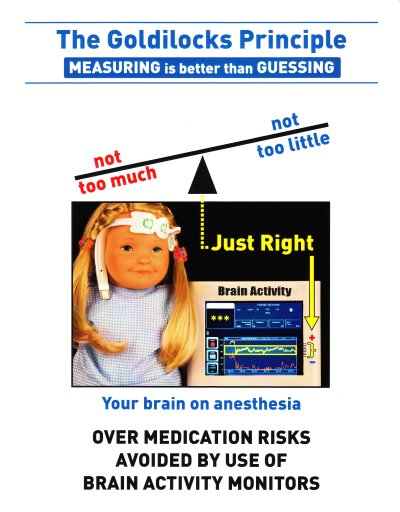Search
Information for Patients - About PK

With brain monitoring, we directly measure your individual response to anesthesia. No longer is dosing based on ‘one size fits most.’
PK anesthesia is state of the art, custom tailored 21st century care for every individual patient’s specific needs at the time of their surgery.
By dosing medication in response to your individual needs, you don’t get ‘too much,’ ‘too little,’ but ‘just right’ (like Goldilocks) is the amount of anesthesia you will get.
Your brain really is ‘in control’ even though you’re asleep through your surgery.
Can you explain how the brain monitor works for me in words the average person can unerstand?
The brain monitor can show 2 lines of information.
The top line shows how your brain is responding to the sleep medication.
This information is delayed from 'real time' by 15-30 seconds.
However, the lower trace is a real time display of the muscle between your eyebrows (EMG).
Activity on this display tells me that something above your neck is happening, even if you only move a litle bit.
During sedation, the meaning of movement (and what to do about) had been the philosophical problem that has plagued anesthesia providers (i.e. anesthesiologists and nurse anesthetists alike) and surgeons for many years before brain monitors existed.
Traditionally, the surgeon would say, "the patient is 'too light,' only to get an anesthesia provider response of 'put some more local in.' "
This exchange would set the stage for a circular argument not unlike the beer commercial in which the actors argued 'tastes great,' no 'less filing,' without a resolution.
The use of the brain monitor with propofol in the range of 60-75% of awake value with the EMG as a second trace, as I advocate, is a legitimate, physician directed off-label use of the brain monitor.
When your brain activity shows 'asleep,' if you move a little bit, a 'spike' in the EMG occurs.
Although you are still asleep, the brain monitor helps the surgeon know to inject more local anesthesia long before you would be able say, 'ouch.'
Your anesthesia provider will also know to give a little more propofol at the same time.
Using the brain monitor in this fashion keeps you from hurting at the beginning of your surgery as well as during your surgery.
When your surgery is finished and your propofol is turned off, you awaken quickly, yet with very little discomfort because of the manner in which your surgery and anesthesia was performed.
To protect yourself, you must be your own patient advocate.
Ask if you will have your brain directly monitored during your surgery.
If you are not satisfied with the answer, you are unlikely to change the belief of the surgeon, faciilty administrator or anesthesia provider who gives the answer to you.
Simply tell them you will have to find a different facility where this monitoring is used.
Please remember 'belief' systems are not rational.
You cannot talk a person out of their belief system.
You can only hope to modify their behavior.
Nausea and vomiting after surgery (PONV)
The secret to preventing this problem comes in two parts:
First, don’t hurt the patient on the operating table.
Pain can make you sick to your stomach.
Second, don't give drugs that make people sick to their stomach
'Stinky gases' like isoflurane, sevoflurane or IV narcotics like fentanyl.
It may come a surprise to you, but anesthesiologists actually had to do a study to learn that vomiting was the #1 issue you most wanted to avoid after surgery.
Gagging on the breathing tube was 2nd, nausea 3rd, and pain 4th.
Ten years after the study, a whole chapter was finally dedicated to PONV for the first time in anesthesia's #1 respected, referenced textbook, MiIler's Anesthesia, 7th ed.
Lest you think the anesthesia profession finally understood the importance of PONV to you, PONV received the 'stepchild' treatment by getting positioned #86 of 102 chapters.
PK anesthesia solved the PONV problem more than 15 years ago.
This web site has been promoting that solution for 8 years on the internet.
The good news about the Miller chapter is that it was written by Dr. Christian Apfel, the world's foremeost PONV authority, .
He wrote that PK anesthesia was a non-PONV technique, a historic endorsement for PK anesthesia.
The other good news is that if PONV has been a problem for you, download a copy of this www.prweb.com/releases/2009/06/prweb2493794.htm. & take it with you when you see your surgeon.
Give the release to the surgeon or anesthesia provider involved with your surgery.
This action on your part cannot guarantee you will receive PK anesthesia.
It will increase the probability of it happening.
As in the case of brain activity monitoring, you cannot change belief systems.
You can only hope to modify behavior.
Ask if you will get PK anesthesia.
If you are not satisfied with the answer, say you will go where you will get this type of anesthesia.
This is the act of an educated, empowered patient.
You are not being 'difficult.'
You are acting in your own best interests.
